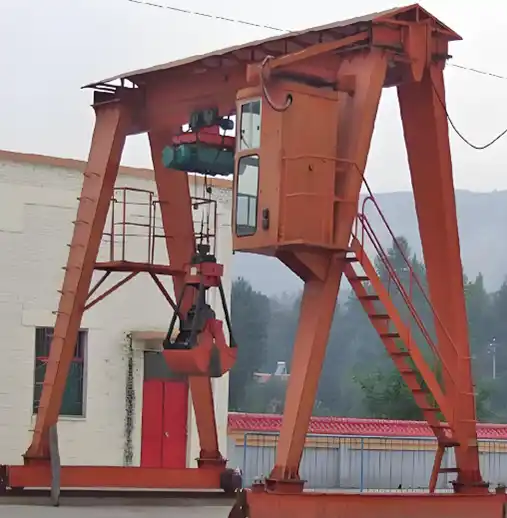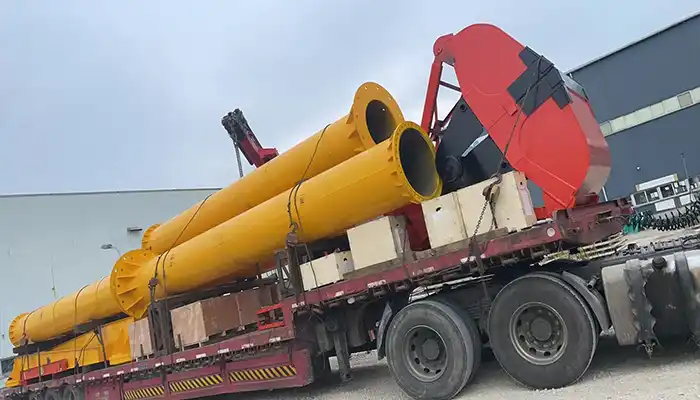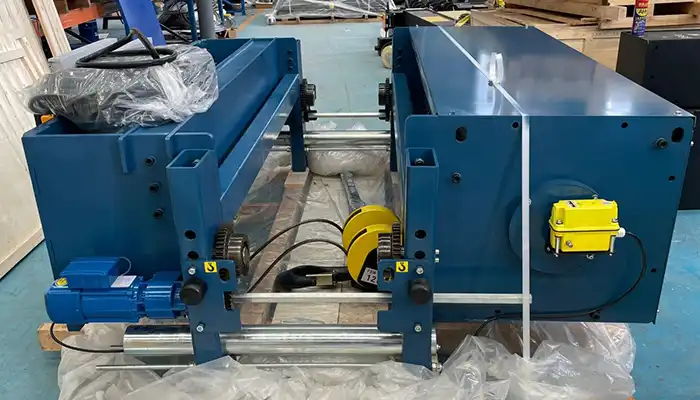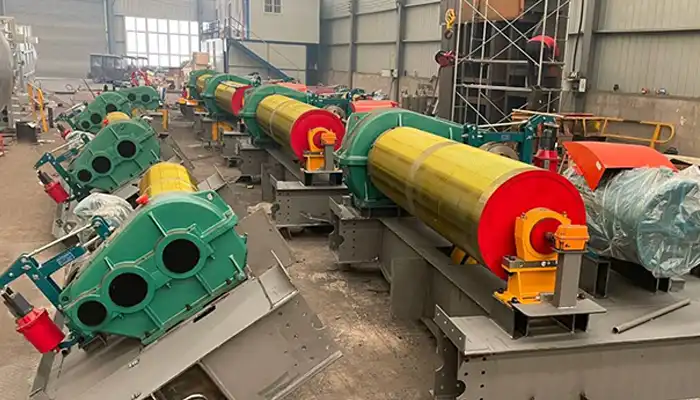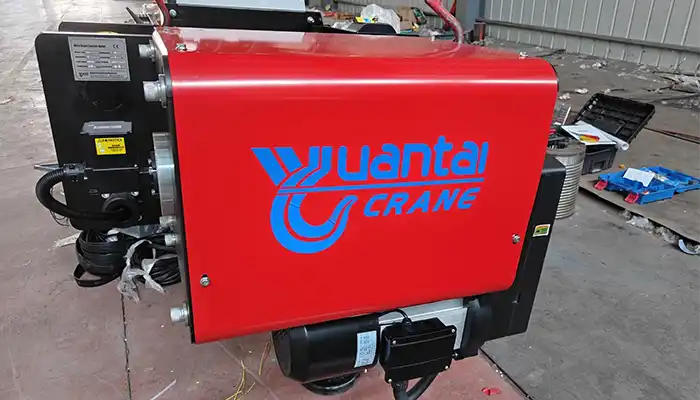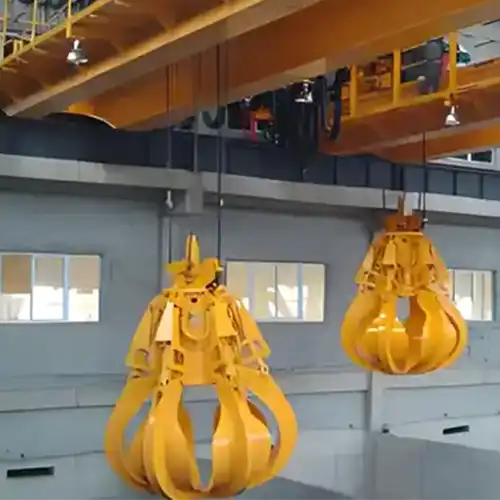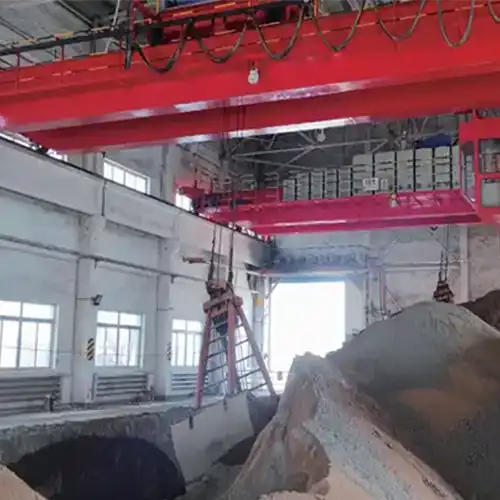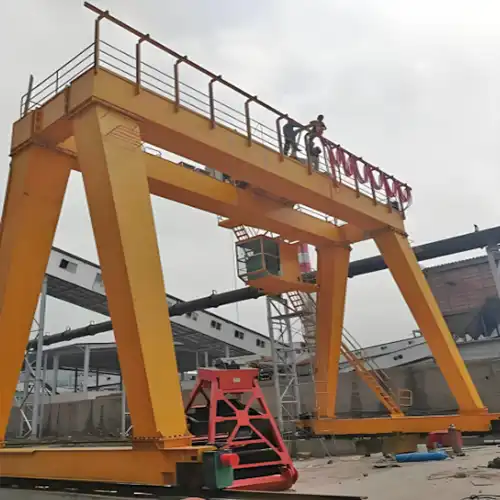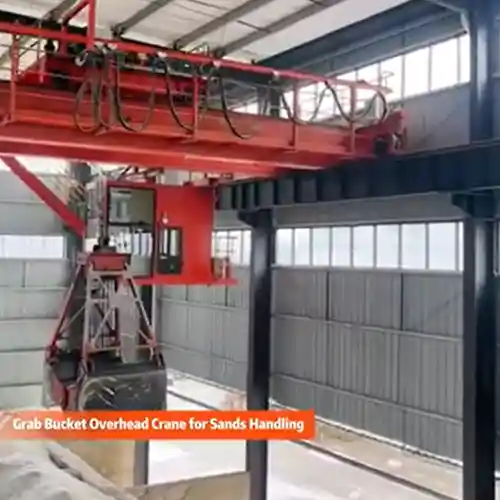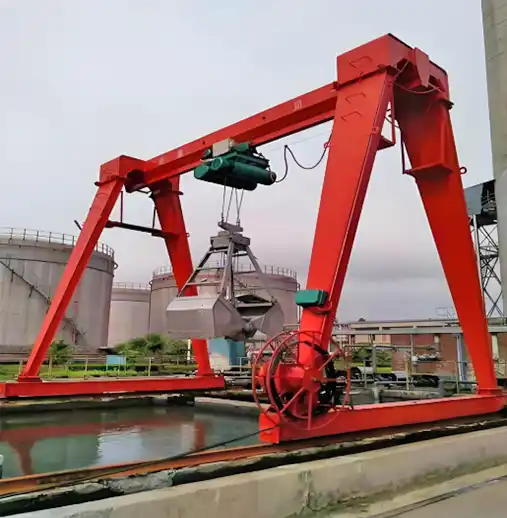Gantry Crane with Grab Bucket for Dredging: A Buyer’s Guide
Heavy duty grab bucket gantry crane for sale. A guide to help buyers choose right goliath gantry crane with grab bucket for efficient dredging operations.
Category: Featured
Your Trusted Goliath Gantry Crane Manufacturer & Supplier
Gantry Crane with Grab Bucket for Dredging: A Buyer's Guide
Heavy duty grab bucket gantry crane for sale. A guide to help buyers choose right goliath gantry crane with grab bucket for efficient dredging operations.
What Are Gantry Cranes with Grab Buckets?
Gantry cranes with grab buckets are machines used to remove debris and sediment from waterways, such as rivers, lakes, and harbors. These cranes have a strong frame that moves along rails, allowing them to lift and carry heavy loads over water. The grab bucket is attached to the crane and is used to scoop materials like dirt, sand, waste, and debris from the water.
These cranes are essential for dredging because the grab bucket allows for precise removal of various materials, including floating waste and pollutants. The crane's stability and the bucket's ability to handle different types of debris make them perfect for keeping waterways clean and navigable. They are particularly useful for tasks that involve clearing channels and preventing sediment buildup in ports or other water bodies.
This guide is created to help crane buyers make the right choice when purchasing a gantry crane with a grab bucket for dredging. It provides important information about how these cranes work, what features to look for, and how to pick the best equipment for your needs.
Whether you're working in harbor maintenance, river dredging, or environmental cleanup, this guide will give you the information you need to make an informed decision. We will cover key factors such as crane capacity, bucket design, power options, and maintenance tips, helping you choose a reliable and cost-effective solution for your dredging projects.

double girder gantry crane with grab bucket for bulk material handling
Key Components of Gantry Cranes with Grab Buckets
Gantry Crane Structure
The gantry crane's structure is designed for strength and stability, ensuring efficient operation during dredging tasks. The key components include:
- Frame: Made from high-strength steel, the crane's frame supports the weight of the crane and the loads it lifts. Its design ensures that it can withstand the demands of dredging operations, even in tough environments like harbors and rivers.
- Rails: Gantry cranes are mounted on rails that guide the crane along its operational path. These rails can be installed along the ground or a structure like a dock, allowing the crane to move horizontally to cover large areas efficiently.
- Hoisting Mechanism: The hoisting mechanism is responsible for raising and lowering the grab bucket. It uses cables or ropes driven by motors to move the bucket smoothly. Electric hoists provide precise control and are ideal for heavy-duty lifting.
- Movement Systems: Gantry cranes are designed to move both horizontally (across the rails) and vertically (lifting and lowering the bucket). Some models also offer the ability to rotate or swivel the boom, enhancing flexibility and enabling precise positioning for dredging tasks.
Grab Bucket Design
The grab bucket is a critical part of the crane's dredging function, designed for efficiently scooping up debris, sand, and other materials from water.
Mechanism: The grab bucket operates using a hydraulic or electric-controlled system that opens and closes the bucket for material collection. Electric controls allow for smooth, precise operation, ensuring that the bucket picks up and releases material accurately.
Types of Grab Buckets:
- 2-Arm Grab Bucket: Ideal for loose, bulk materials like sand or gravel, this type features two arms that open and close to scoop up debris. It is typically used in shallower waters where precision isn't as critical.
- 4-Arm Grab Bucket: This design provides more precise control with four arms, making it suitable for dredging in deeper waters or collecting smaller or more delicate debris. The additional arms offer more stability and accuracy during operation.
Capacity Options: Grab buckets come in various capacities, typically ranging from 1 to 10 tons, depending on the material being handled. The choice of capacity is based on the type and volume of material to be dredged, with larger buckets available for more demanding jobs.
Electric Power Systems
Electric power is the preferred choice for gantry cranes and grab buckets due to its efficiency, environmental benefits, and lower operating costs. Key features of electric power systems include:
- Electric Drive Systems: Electric-powered gantry cranes offer precise control and high efficiency for dredging operations. These systems use electric motors to drive the crane's movement along rails and operate the hoisting mechanism, ensuring smooth and controlled lifting and lowering of the grab bucket.
- Electric Hoists: Electric hoists provide reliable lifting power and accurate load control. They are designed to handle heavy-duty operations like dredging while reducing the maintenance and fuel costs associated with other power sources.
Advantages of Electric Power:
- Environmentally Friendly: Electric cranes produce zero emissions, making them ideal for use in areas where environmental concerns are a priority, such as near sensitive ecosystems or urban locations.
- Lower Operating Costs: Compared to diesel-powered cranes, electric cranes have lower fuel and maintenance costs, offering long-term savings.
- Quiet Operation: Electric systems run more quietly than diesel engines, making them more suitable for areas with noise regulations or where quiet operations are needed.
- Precision and Reliability: Electric power systems provide smoother and more consistent performance, which is essential for accurate material handling in dredging projects.
Choosing an electric-powered gantry crane with a grab bucket offers numerous advantages, particularly in terms of environmental impact, operational costs, and performance efficiency. These benefits make electric cranes the ideal solution for modern dredging and debris removal tasks.
How Gantry Cranes with Grab Buckets Work
Operation of Gantry Cranes
Gantry cranes with grab buckets are designed to handle large-scale dredging tasks efficiently. Here's how they operate:
- Movement Along Rails: The gantry crane operates on a set of rails, which are typically positioned along the water's edge or within a dock area. The crane can move horizontally along these rails to cover a large area, providing the ability to reach different sections of the waterway for dredging. This horizontal movement allows for flexibility in accessing hard-to-reach spots, making the crane ideal for clearing sediments, waste, and debris across a broad region.
- Vertical Lifting and Lowering: The crane's hoisting mechanism allows for precise vertical movement. The grab bucket is lifted from the water, moved to the designated dumping area, and then lowered back into the water to scoop up more material. This operation allows for continuous and efficient dredging without the need for repositioning the crane frequently.
- Swinging and Rotation: Many gantry cranes are equipped with the ability to swing or rotate the boom. This feature provides additional flexibility in positioning the grab bucket at different angles, making it easier to scoop materials from various locations within the work area without needing to move the entire crane.
The combination of horizontal and vertical movement, along with boom rotation, makes gantry cranes highly efficient for dredging projects. These features allow for smooth operation, enabling the crane to handle large volumes of material over an extended period.
Grab Bucket Functionality
The grab bucket is the crucial component of the gantry crane used to collect and remove debris or sediment from the water. Here's how it works:
Control Systems: The grab bucket can be controlled in various ways, depending on the crane's design and the specific dredging requirements:
- Manual Control: Some grab buckets are operated manually, where an operator controls the opening and closing of the bucket using a rope or mechanical system. This setup is simple and cost-effective, but may not offer the precision and efficiency of hydraulic or electric systems.
- Hydraulic Control: Most modern grab buckets are controlled by hydraulic systems, which offer greater control and efficiency. The hydraulic system powers the opening and closing of the bucket's arms and allows the operator to precisely scoop up materials. This type of control is especially useful in handling heavy, compacted materials or when precision is critical.
- Rope Systems: In some cranes, a rope system is used to control the bucket. The operator pulls on ropes to open and close the bucket. While this system is simpler than hydraulics, it is typically used in smaller, less demanding dredging operations.
Scoop and Removal: Once the grab bucket is positioned over the dredging site, the operator activates the control system to open the bucket. The bucket scoops up materials such as sand, silt, waste, or debris from the water. After collecting the material, the bucket closes and is lifted out of the water to a designated disposal or dumping area. The grab bucket's ability to precisely scoop and hold material ensures that dredging can be done quickly and efficiently without losing any of the collected debris.
The grab bucket's design and functionality are critical in making the dredging process efficient and cost-effective. The control systems allow operators to handle a variety of materials, while the lifting and lowering mechanism ensures smooth and continuous dredging operations.
Applications of Gantry Cranes with Grab Buckets in Dredging
Gantry cranes with grab buckets are versatile machines used in various dredging operations. Here are the key applications where these cranes play a crucial role in maintaining waterways, preventing pollution, and ensuring the proper flow of water:
Harbor Dredging
In ports and harbors, gantry cranes with grab buckets are essential for maintaining navigable waterways. Over time, sediment, debris, and silt can accumulate on the seabed, obstructing the passage of ships and causing shallow water depths. These cranes are used to:
- Remove Sediment: The grab bucket efficiently scoops up mud, sand, and silt from the harbor floor, helping maintain adequate depth for vessels.
- Clear Debris: Floating and sunken debris, such as wood, trash, and other waste, can be cleared to ensure that the harbor remains safe and accessible.
By regularly dredging harbors, these cranes ensure that ports stay operational and capable of handling large ships, reducing the risk of navigational hazards.
River and Canal Maintenance
Rivers and canals require regular maintenance to keep water flowing smoothly and prevent sediment build-up, which can obstruct the passage of boats and reduce water quality. Gantry cranes with grab buckets are used for:
- Sediment Removal: They remove sand, silt, and other particles that accumulate on river and canal beds, maintaining the required depth for safe navigation.
- Preventing Blockages: The cranes help remove debris that can cause blockages, preventing flooding and ensuring that water flows freely, especially during heavy rainfall.
Regular dredging with these cranes ensures the efficient functioning of rivers and canals, preventing silting and maintaining navigability for boats, barges, and other watercraft.
Pollution Cleanup
One of the most valuable uses of gantry cranes with grab buckets is in the cleanup of polluted water bodies. These cranes are ideal for removing floating waste, plastics, and pollutants from oceans, lakes, and rivers. Their applications include:
- Plastic and Waste Removal: Grab buckets can scoop up floating debris, including plastics and non-biodegradable waste, which are harmful to aquatic life and the environment.
- Pollution Control: By removing pollutants from the water surface, these cranes help prevent the spread of contaminants and maintain cleaner water bodies.
Using these cranes for pollution cleanup contributes to environmental preservation by preventing further contamination of water ecosystems.
Reservoir and Lake Dredging
In reservoirs and lakes, sediment accumulation can affect water quality, reduce storage capacity, and impair the flow of water. Gantry cranes with grab buckets are used for:
- Sediment Removal: These cranes effectively remove organic and inorganic materials from the lake or reservoir bed, maintaining the desired water depth and preventing the stagnation of water.
- Optimizing Water Flow: Regular dredging ensures that water flows efficiently within the reservoir, improving water supply for irrigation, drinking, and power generation in hydroelectric plants.
- Improving Water Quality: By eliminating accumulated sludge and pollutants, these cranes help improve the overall water quality in lakes and reservoirs, making the water more suitable for recreational, agricultural, and industrial use.
Through dredging operations, gantry cranes with grab buckets help ensure that lakes and reservoirs remain functional and support their intended purposes, whether it's water supply, recreation, or hydroelectric power generation.
These applications showcase the versatility of gantry cranes with grab buckets, making them indispensable tools for maintaining water bodies and supporting environmental sustainability.

Anti-corrosion-grab bucket crane for sale , customized single girder gantry crane with gra bucket

Outdoor gantry crane with grab bucket for bulk material handling

Goliath gantry crane with grab bucket for dredging handling
Benefits for Grab Bucket Crane Buyers
When purchasing a gantry crane with a grab bucket for dredging, crane buyers can expect several key benefits that make these machines a worthwhile investment. These advantages not only enhance operational efficiency but also reduce costs and increase the lifespan of the equipment.
Efficiency in Large-Scale Projects
Gantry cranes with grab buckets are designed to handle large-scale dredging operations efficiently. The combination of high lifting capacities and precise movement systems allows these cranes to quickly and effectively scoop up large volumes of sediment, debris, and other materials. This efficiency translates into:
- Faster Completion: The speed at which these cranes can perform dredging tasks helps reduce project timelines.
- Reduced Labor Requirements: With fewer operators needed to control the crane and perform tasks, labor costs are minimized.
For crane buyers, this means that they can complete dredging operations faster and with fewer resources, improving productivity on large-scale projects.
Cost-Effective
Investing in a gantry crane with a grab bucket offers a highly cost-effective solution for dredging operations. These cranes eliminate the need for multiple machines and workers to carry out the same tasks, which leads to:
- Lower Operational Costs: Fewer machines and crews are required, reducing both capital and ongoing expenses.
- Reduced Downtime: The efficient design of the crane ensures less downtime for maintenance, helping to further reduce operational costs.
For crane buyers, this means long-term savings on both equipment and manpower, making it a smart investment for dredging projects of any size.
Durability and Longevity
Gantry cranes with grab buckets are designed to withstand the harsh conditions of water environments, such as saltwater exposure, extreme temperatures, and continuous movement. The robust construction of these cranes offers:
- Longer Service Life: Built with high-quality materials and protective coatings, these cranes can endure years of use in demanding conditions.
- Reduced Maintenance Needs: Thanks to their durability, these cranes require less frequent maintenance and repair, which lowers overall maintenance costs.
For crane buyers, this means investing in equipment that offers reliable performance over an extended period, leading to better long-term value.
Versatility
One of the greatest benefits of gantry cranes with grab buckets is their versatility in handling various materials. These cranes can efficiently scoop and remove different types of debris, including:
- Silt and Sediment: Perfect for maintaining waterways, such as rivers and canals, where sediment build-up is common.
- Debris: The grab bucket is capable of picking up floating waste, such as plastics, logs, and other debris, helping to keep waterways clean.
- Pollutants: The cranes can also be used for removing pollutants from water bodies, supporting environmental clean-up efforts.
For crane buyers, this versatility makes the gantry crane with grab bucket an ideal solution for a wide range of dredging applications, whether it's for maintenance, pollution control, or waterway restoration.
In summary, a gantry crane with a grab bucket offers crane buyers a combination of efficiency, cost savings, durability, and versatility, making it an essential tool for large-scale dredging and environmental projects.
Selecting the Right Gantry Crane with Grab Bucket
Choosing the right gantry crane with a grab bucket for dredging is a critical decision that impacts the success of the project. Crane buyers must consider various factors to ensure that the equipment is suitable for the specific dredging tasks, environmental conditions, and operational requirements. Below are key aspects to consider when selecting the right gantry crane with a grab bucket.
Capacity Considerations
The size of the crane and the grab bucket is determined by the project's scale and the type of material being handled. Here's how to select the right capacity:
Project Size: For larger dredging projects, a crane with a higher lifting capacity is necessary to handle significant volumes of material. Smaller projects or light-duty dredging operations may require a crane with a lower capacity.
Material Type: The type of material being dredged affects the choice of grab bucket. For example:
- Heavy Sediment: A larger grab bucket with reinforced structures will be needed for heavy sediment or compacted debris.
- Light Debris and Floating Waste: For dredging floating waste or lighter materials, a smaller grab bucket may be sufficient.
Matching the crane's lifting capacity with the project's requirements ensures that the equipment operates efficiently without overloading or underperforming.
Waterway Conditions
The conditions of the waterway directly influence the crane and bucket selection. Factors such as water depth, flow conditions, and environmental factors play a significant role:
Water Depth: In deeper waters, cranes with longer boom reach and the ability to extend further into the water are needed. Shallower waters may require a smaller crane or one with more compact design.
Flow Conditions: Strong currents or tidal movements may require a more stable crane design to prevent tipping or instability. Cranes with additional counterweights or stabilizers may be necessary for areas with fast-moving water.
Environmental Factors: Factors such as temperature, salinity, and exposure to chemicals can influence the material and design of the crane. For example:
- Corrosive Environments: In saltwater or areas with high humidity, cranes should be made from corrosion-resistant materials or equipped with protective coatings.
- Extreme Weather: Cranes used in regions with high winds or frequent storms need to be equipped with reinforced structures to withstand harsh weather conditions.
Understanding the specific waterway conditions helps crane buyers select equipment that will perform well and ensure safety during operations.
Site Requirements
The physical layout of the dredging site plays a key role in determining the appropriate crane system. Site requirements such as accessibility, space, and mobility will influence the crane choice:
- Fixed Tracks vs. Portable Systems: If the site has permanent infrastructure, such as fixed tracks, a crane with a dedicated rail system may be suitable. However, if the dredging area is more flexible or spread across different locations, a portable crane with a traveling system may be required.
- Space Constraints: If the work area is confined or restricted, cranes with a smaller footprint or compact design should be selected to maximize maneuverability. Some cranes are designed to operate in tight spaces, offering flexibility without compromising performance.
- Site Accessibility: Cranes with a track system or portable systems must be chosen based on the ease of access to the work area. If the site has rough or uneven terrain, a crane with mobility options that can navigate these conditions should be considered.
By carefully evaluating the site's physical conditions and choosing the crane system accordingly, buyers can ensure efficient and safe operations in a variety of environments.
Selecting the right gantry crane with a grab bucket for dredging is essential for optimizing project performance. By considering the crane's lifting capacity, the waterway conditions, and the site's specific requirements, crane buyers can make an informed choice that best suits their operational needs. Whether it's for large-scale projects or specific environmental conditions, the right selection ensures maximum efficiency, safety, and longevity for dredging operations.
Key Features to Look for in a Gantry Crane with Grab Bucket
When selecting a gantry crane with a grab bucket, several key features should be considered to ensure the crane is well-suited for the dredging operation. These features directly impact the crane's performance, durability, and efficiency. Below are the essential aspects to look for when choosing the right gantry crane with a grab bucket.
Lifting Capacity
The lifting capacity of the gantry crane and grab bucket is a critical factor in determining whether the equipment will be effective for the job. Choosing the right lifting capacity ensures the crane can handle the weight of the materials being removed without overloading or underperforming. Consider the following:
- Type of Material: Different materials have varying weights, and choosing the correct lifting capacity ensures efficient and safe operation. For instance, heavier materials like large rocks or compacted sediment require a higher lifting capacity.
- Project Size: Large-scale dredging projects involving significant volumes of debris or sediment will need a crane with a higher lifting capacity, while smaller projects may only require a crane with a lower capacity.
By matching the lifting capacity with the type and amount of material being handled, crane buyers can optimize crane performance and reduce the risk of operational issues.
Corrosion Resistance
Crane buyers must consider the environment in which the crane will be used. Gantry cranes operating in marine, river, or coastal environments are exposed to saltwater and high humidity, which can cause significant corrosion. To ensure longevity and reliable performance, look for the following corrosion-resistant features:
- Anti-Corrosion Coatings: Cranes operating in marine environments should have specialized anti-corrosion coatings or galvanization on all metal surfaces to protect against rust and degradation.
- Stainless Steel Components: Key parts of the crane, including the hoist mechanisms and grab bucket, should be made from corrosion-resistant materials like stainless steel to reduce maintenance and extend the crane's life.
- Rust-Proof Design: A robust design that includes sealed joints and components designed to withstand harsh weather conditions is essential to prevent rust and corrosion.
Corrosion-resistant features significantly reduce maintenance costs and ensure the crane continues to perform efficiently over time, even in challenging environmental conditions.
Grab Bucket Design
The design of the grab bucket is another crucial factor in the performance of a gantry crane. The right bucket ensures efficient material handling and optimal productivity. Important design considerations include:
- Bucket Size: The size of the grab bucket should be selected based on the type and amount of material being dredged. A larger bucket is ideal for large volumes of sediment or debris, while a smaller bucket may be suitable for lighter, smaller materials.
- Bucket Type: There are various grab bucket designs, such as 2-arm or 4-arm buckets. A 2-arm bucket is generally used for lighter materials or areas with shallow water, while a 4-arm bucket provides better control and is ideal for heavy or dense materials.
- Bucket Durability: The material of the grab bucket should be durable enough to withstand constant use in dredging operations. Look for high-strength materials and wear-resistant features, especially for projects with abrasive or heavy materials.
Selecting the right grab bucket size and type ensures efficient material handling and reduces wear and tear on the equipment.
Control Mechanisms
Control systems are essential for the smooth operation of the crane and grab bucket. The control system allows operators to precisely maneuver the crane and scoop materials. There are several control options to consider:
- Hydraulic Controls: Hydraulic systems offer high precision and power, allowing the operator to control the grab bucket's opening and closing mechanism with ease. Hydraulic systems are ideal for heavy-duty applications where precision is key.
- Electric Controls: Electric control systems provide a more energy-efficient solution, offering smooth operation for a wide range of tasks. Electric controls are ideal for environments where low power consumption is a priority.
- Manual Controls: For smaller operations or where simplicity is preferred, manual control systems are available. These are cost-effective and suitable for less complex dredging tasks but require more direct operator involvement.
The choice of control mechanism depends on the project requirements, material handling needs, and the level of control necessary for optimal performance.
Selecting a gantry crane with a grab bucket requires careful consideration of several important features, including lifting capacity, corrosion resistance, grab bucket design, and control mechanisms. These features determine how well the crane will perform in dredging operations and how long it will last. By ensuring that these key features are tailored to the specific needs of the dredging project, crane buyers can make informed decisions that maximize efficiency, reduce costs, and ensure the durability of the equipment.
Maintenance and Longevity
Proper maintenance is crucial to the longevity and performance of gantry cranes with grab buckets. Regular checks and proactive care not only ensure smooth operations but also help avoid costly repairs and downtime. Here are key aspects to consider for maintaining your equipment.
Routine Inspection
Routine inspections are the foundation of a well-maintained crane. These checks should focus on the following areas:
- Crane Structure: Regularly inspect the crane's frame and rails for signs of wear, cracks, or structural damage. Check for any bent or misaligned parts that could affect movement and stability. Ensure the tracks are clean and free from debris to prevent obstruction.
- Grab Bucket: Examine the grab bucket for any signs of excessive wear or damage. Pay attention to the bucket's arms, teeth, and the mechanism used for opening and closing. Ensure that the bucket operates smoothly without unnecessary friction or difficulty.
- Hydraulic Systems: The hydraulic system is critical for controlling the grab bucket's movements. Check for leaks, worn seals, and the condition of the hydraulic hoses. Ensure that fluid levels are maintained and that there are no blockages or loss of pressure, as this can affect the efficiency of the crane's operation.
- Lifting Mechanism: Inspect the hoisting cables, winches, and motors to ensure they are in good working condition. Test the lifting function to ensure smooth operation without jerking or inconsistent movements.
A well-maintained crane and grab bucket system will significantly extend the equipment's life and improve its performance during dredging tasks.
Anti-Corrosion Coatings
Cranes operating in harsh, saline, or chemically exposed environments are at a higher risk of corrosion, which can drastically reduce the lifespan of the equipment. To combat corrosion and extend the life of your crane, focus on the following:
- Regular Coating Inspection: Periodically inspect the anti-corrosion coatings on crane components. Look for any signs of peeling, cracking, or wear that expose metal surfaces to the environment. Immediate re-coating is necessary to prevent rust and further deterioration.
- Use of High-Quality Coatings: Ensure that the crane is equipped with corrosion-resistant materials such as galvanized steel or materials treated with anti-corrosive coatings. For marine environments, special marine-grade coatings should be used.
- Environmental Factors: Monitor the environmental conditions around the crane. If the crane is exposed to saltwater, consider reapplying protective coatings more frequently to ensure continued resistance to corrosion.
Proper anti-corrosion maintenance helps in maintaining the crane's structural integrity and reduces the risk of unexpected breakdowns, keeping operational costs low.
Troubleshooting Common Issues
Over time, gantry cranes with grab buckets may face certain mechanical issues, particularly with heavy usage. Here's how to handle some common problems:
- Misalignment: If the crane or grab bucket experiences misalignment, it may be due to worn rails or improper adjustments in the crane structure. To resolve this, ensure that the crane tracks are properly aligned, and the wheels are in good condition. Misalignment can also be caused by uneven wear on the grab bucket's lifting components, so inspect the lifting mechanism for signs of uneven wear and replace parts as needed.
- Mechanical Failure: Mechanical issues such as a malfunctioning hoist, winch, or grab bucket can occur. In such cases, inspect the motor and electrical systems to ensure they are working correctly. Also, check for any broken or frayed cables that could compromise performance. Always consult the crane's manual for troubleshooting guidelines and repair instructions.
- Power Loss: If the crane experiences power loss, check the power system (whether electric or hydraulic). Ensure there is a steady supply of electricity or hydraulic pressure. For electric-powered cranes, verify the connection to the power source and inspect the electrical components for any faults or loose connections. For hydraulic-powered cranes, inspect the hydraulic pump and fluid levels to ensure optimal performance.
By proactively addressing these common issues and performing regular maintenance, crane owners can avoid expensive repairs and keep the equipment running smoothly for years.
Effective maintenance is the key to maximizing the operational lifespan of a gantry crane with a grab bucket. Regular inspections, ensuring corrosion protection, and troubleshooting common issues as they arise will ensure the crane performs efficiently and safely. By maintaining your crane properly, you not only improve performance but also protect your investment, ensuring that the equipment remains in top condition for extended use.
Cost Factors and Budget Considerations
When purchasing a gantry crane with a grab bucket for dredging, it's essential to consider both the initial purchase cost and ongoing operational expenses. Understanding the factors influencing price and how to assess long-term value can help crane buyers make informed decisions that balance budget with operational efficiency.
Initial Purchase Cost
The initial purchase cost of a gantry crane with a grab bucket varies depending on several key factors:
- Crane Capacity: The lifting capacity of the crane plays a significant role in its price. Cranes with higher lifting capacities (e.g., 20 tons or more) tend to be more expensive than those with lower capacities. This is because higher capacity cranes require stronger components, including reinforced frames, larger motors, and more robust lifting systems.
- Grab Bucket Size and Design: The size and design of the grab bucket are other factors that influence the price. Larger or specially designed buckets (such as 4-arm buckets for heavy debris) are typically more expensive than standard 2-arm models. Additionally, grab buckets designed for specific materials or environmental conditions (e.g., corrosion-resistant coatings for marine environments) will also add to the cost.
- Custom Features: Any custom features, such as specialized control systems, weather-resistant coatings, or unique material handling capabilities, can drive up the price. Buyers who need a crane tailored to specific dredging tasks or environmental conditions will likely face higher upfront costs.
Operational Costs
Once the crane is operational, there are various ongoing expenses that crane buyers should account for:
- Fuel Costs: Gantry cranes powered by diesel or electric motors require regular fuel or electricity. Fuel costs can vary depending on the crane's power system and how frequently the crane is used. Diesel-powered cranes generally have higher fuel costs than electric models, though electric cranes may have higher initial costs.
- Maintenance Costs: Maintenance is an essential ongoing expense for gantry cranes. Regular inspections, repairs, and parts replacements (such as cables, hoists, and hydraulic components) can add to operational costs. High-quality cranes with durable parts will generally require fewer repairs and have lower maintenance costs over time.
- Manpower Expenses: The number of operators and maintenance staff needed to run and service the crane impacts the overall cost of operation. Electric cranes may require less manpower for operation compared to diesel cranes, which often require more technical expertise. It's essential to factor in training costs and the wages of crane operators and maintenance teams when calculating operational expenses.
By considering these ongoing operational costs, crane buyers can determine how much it will cost to run the crane over its lifespan and whether it fits within their operational budget.
Long-Term Value
Investing in a high-quality gantry crane with a grab bucket provides long-term value that can offset the higher initial purchase cost. Here are several ways in which a durable and efficient crane offers long-term financial benefits:
- Durability and Reliability: High-quality cranes are built to withstand demanding dredging tasks and harsh environments, ensuring that they last longer and require fewer repairs. A well-built crane with a durable grab bucket can withstand the wear and tear of continuous dredging operations, reducing the frequency and cost of maintenance and repairs.
- Improved Efficiency: A well-designed gantry crane with an efficient grab bucket system can improve dredging performance, reducing the time needed for each operation. This efficiency translates into lower operational costs and more productive use of labor and resources. Faster dredging operations can lead to quicker project completion and the ability to take on more projects in the same amount of time.
- Reduced Downtime: Cranes with better-quality components and effective design experience less downtime due to breakdowns or repairs. Investing in a crane with long-term reliability ensures fewer interruptions to dredging operations, maximizing uptime and profitability.
- Energy Efficiency: Electric-powered gantry cranes often have better energy efficiency than their diesel counterparts, leading to lower fuel costs over time. Additionally, electric cranes may benefit from reduced environmental impact, which is an increasingly important consideration for companies focusing on sustainability.
In the long run, investing in a high-quality crane with grab bucket technology may have a higher upfront cost, but the savings from reduced maintenance, energy costs, and higher productivity can provide substantial returns over the crane's operational lifespan.
When evaluating the purchase of a gantry crane with a grab bucket, it's essential to weigh the initial purchase cost against the long-term operational costs and value. While high-quality cranes with larger capacities and custom features may carry higher upfront prices, they provide significant long-term benefits in terms of durability, efficiency, and reduced maintenance costs. Crane buyers should consider all aspects—initial price, operational expenses, and long-term value—when making an informed decision that aligns with both their budget and dredging project goals.
Conclusion
In this guide, we have explored the critical factors surrounding gantry cranes with grab buckets for dredging and debris removal. The key points to consider when purchasing such equipment include:
- Functionality: Gantry cranes with grab buckets are essential for large-scale dredging projects, effectively handling materials like sediment, waste, and debris in various environments such as harbors, rivers, and lakes.
- Power and Drive Systems: Electric-powered gantry cranes offer operational efficiency and low maintenance costs, making them ideal for environmentally conscious and budget-conscious buyers.
- Applications: These cranes are highly versatile, with applications in harbor dredging, river cleanup, pollution removal, and more. They play a vital role in maintaining navigable waterways and promoting environmental sustainability.
- Maintenance and Durability: Regular inspection, anti-corrosion coatings, and proper maintenance ensure that gantry cranes perform effectively over time, reducing long-term operational costs and increasing longevity.
- Cost Factors: Buyers should carefully evaluate initial purchase costs, operational expenses, and the long-term value that a high-quality crane can offer in terms of durability and efficiency.
Final Recommendations
When selecting a gantry crane with a grab bucket for dredging operations, it's essential to consider the following tips:
- Assess Project Scale: Understand the size and scope of your dredging project. Larger projects may require cranes with higher lifting capacities, while smaller operations may benefit from compact, more affordable options.
- Material Handling Needs: Consider the type of material to be removed (sediment, debris, pollutants) and choose a grab bucket with the appropriate size and type (2-arm or 4-arm) to handle the materials efficiently.
- Waterway Conditions: Ensure the crane is suited to the specific water conditions of your project, such as water depth, flow, and environmental factors that could affect crane performance.
- Budget Considerations: Balance the upfront cost of the crane with its long-term value. High-quality, durable equipment may require a higher initial investment but will save on maintenance and operational costs over time.
By evaluating these factors carefully and considering your project's unique requirements, you can make an informed decision that will lead to more efficient, cost-effective dredging operations and long-term success. Contact us today to get your customied dredging handling grab bucket gantry crane for your needs!
Main Projects
Related Products
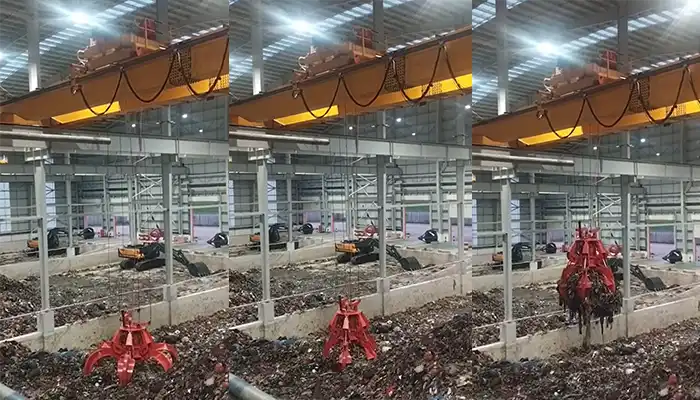
Supplied three grab bucket crane kits to Indonesia, enhancing garbage handling efficiency with high load capacity and reliable performance.
Free consultation to Confirm Parameters & Specifications and Get
Latest Crane Price & Crane Rate.
- Types of overhead cranes : _______?
- Optional: Overhead travelling crane, goliath gantry crane,Slewing jib crane, Single girder or double girder crane,small portable crane or kbk crane, etc.
- Capacity of overhead crane: _______?
- Optional: 0.25ton, 0.5 ton, 1 ton, 2 ton, 3ton, 5 ton, 10 ton,15ton, 20ton, 25 ton, 30ton,35ton, up to 550ton, etc.
- Crane span & lifting height : _______?
- Crane travelling length : _____?
- Control of overhead crane:_______?
- Optional: pendant/ remote/cabin control
- Voltage supply of overhead crane:_____?
- Eg,: 380V50/60HZ,3Phase or others,etc.
- Application/usage of crane:_______?
- Eg,: Steel mill, ,injection mold, cement,stone, concrete,granite, general manufacturing, etc.
Just leave a message via the contact form and our hoist and crane engineer will contact you with in 24working hours.
Get In Touch
